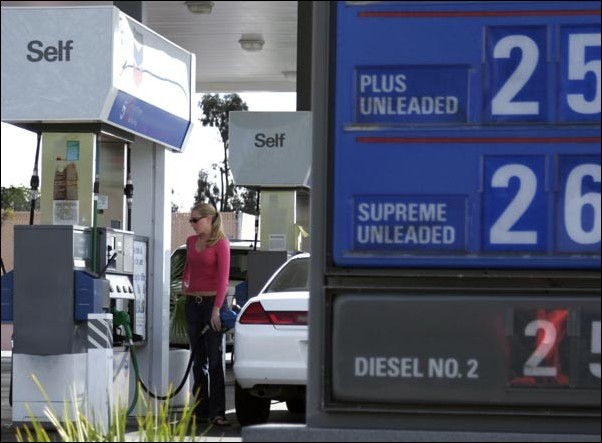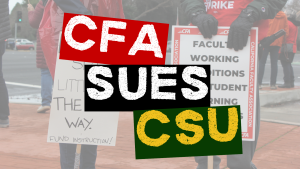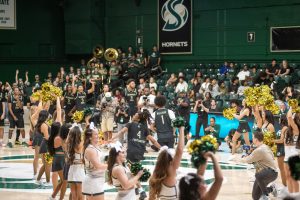Full tanks empty piggy banks
Image: Full tanks empty piggy banks:Sacramento State student Jennifer Nielsen fills her gas tank at a local Chevron station. Joseph Montalvo/State Hornet:
April 6, 2005
Prices at gas pumps have steadily increased, and it has put a strain on students.
Students will continue to feel the pain, as costs of gas will continue to rise, said Jonathan Kogan, energy information specialist with the Energy Information Administration, a part of the U.S. Department of Energy.
Kogan said gasoline prices will peak at an average of $2.15 per gallon this spring and only gradually drop, staying above $2 until late summer when prices might decrease more dramatically.
Ed Dammel, associate professor in civil engineering at Sacramento State, said he has been driving his 1997 Honda Accord 250 to 300 miles per week, which includes his commute to campus five days per week and also his frequent errand-running and weekend trips.
He said he&s not happy with the amount of money he spends on gas.
&It&s money that could be spent on a better house and better things,& said Dammel, who is already looking into the idea of purchasing a hybrid vehicle that utilizes electricity to reduce gasoline consumption.
The gasoline prices have Taylor Smith, a freshman at Sac State, working more and cutting back on things she both likes and needs.
&The prices are making me work more, shop less and buy fewer groceries,& Smith said.
She said she hopes gasoline prices will stop rising.
&It&s frustrating,& said Heather Mummaw, medical records supervisor for the Student Health Center.
She said she doesn&t see the need for people to pay for gas when it&s such an everyday necessity.
But it&s necessity that&s driving prices up, Kogan said.
He said that growth in places like the United States and China has been increasing demand for gasoline and increasing prices.
Crude oil 8211; oil that is pumped out of the ground and later refined so that it can be used in vehicles 8211; has increased $20 above what it cost a year ago, Kogan said.
About 50 percent of the cost people pay at the gas pump is crude oil.
&We expect continued strong world demand,& Kogan said.
Smith said her strong demand for gasoline has her at the pump once a week, costing her $35 every time.
&(The prices) are way too high,& she said.
Although prices are high, they&re still not the highest they&ve ever been.
According to the U.S. Department of Energy, gasoline cost $1.37 in 1981, which in today&s dollars would be $2.32 per gallon.
The national average is currently at $2.10 per gallon.
And the United States has relatively cheap gasoline when compared to other countries, Kogan said.
In France, gasoline is at $5.50 per gallon; Germany, $5.70 per gallon; and in the United Kingdom, $5.94 per gallon.
Although below other countries& gasoline prices and beneath the national record high, prices are still rising in the U.S., according to statistics online with the U.S. Department of Energy.
Gasoline prices have raised 4.4 cents per gallon nationally and 6.4 cents at California pumps.
Smith said she feels helpless about the continued rise in prices.
&There&s nothing I can do about it,& she said.
Mike Wiley, who works for Sacramento Regional Transit, said there is something that can be done.
He said Regional Transit is working with university President Alexander Gonzalez to improve alternative transportation on campus.
Since the early 1990s, Sac State and Regional Transit have provided students with free transportation by bus and light rail if they have a valid OneCard.
&It&s been very successful,& said Wiley, whose statistics showed that between light rail and bus, a total of 629,050 people used alternative transportation last year.
To increase success, he said there are plans to have a trolley-like vehicle that will operate on a rail system, connecting students to several places on campus, instead of only offering the light rail station at 65th Street and the bus stop at the university&s J Street entrance.
Right now, the bus service and light rail are good, but students still have to walk a lot to get to where they need to go on campus, Wiley said.
The trolley-like vehicle will loop around campus and through the tunnel that leads to 65th Street and the light rail station.
Funding and other specifics have not been decided yet, but a survey might soon be coming out on campus, asking students what they think about the new alternative transportation plan, Wiley said.
Sac State also has several bike paths, trails and a shuttle service called The Hornet Express, which help students, faculty and staff cut down on driving.
Smith said she lives two to three minutes from campus and takes the shuttle to and from school to cut down on driving.
Dammel said he tries riding his bicycle to and from campus at least three days a week to reduce his spending on gasoline.
8211;8211;8211;8211;8211;8211;8211;8211;8211;8211;8211;8211;8211;8211;8211;8211;8211;8211;8211;8211;8211;8211;8211;8211;8211;8211;8211;8211;
Sarah Pollo can be reached at [email protected]























































































































